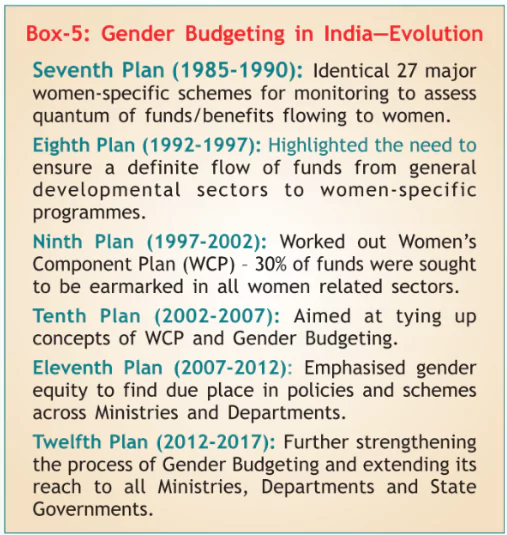First-ever National Consultation on Gender Budgeting organized by the Union Ministry of Women and Child Development (MWCD).
- The Ministry also launched a ‘Gender Budgeting Knowledge Hub’ portal.
Gender Budgeting Knowledge Hub
- A web-based digital repository for all information related to gender budgeting processes
- Purpose:
- Intended to support central and state ministries/departments, and other stakeholders.
- Acts as a centralised knowledge platform to help integrate a gender lens into public policy and budgeting at both Central and State levels.
Key Features:
- Policy briefs, best practices, and case studies
- Gender-disaggregated data
- Training materials and tools for capacity building
|
Understanding Gender Budgeting: A Global and Indian Perspective
- OECD Definition: A policy tool used by governments to close gender gaps by ensuring gender perspectives are integrated into budgetary processes.
- Functionality and Rationale:
- Tool for Gender Mainstreaming: Gender budgeting applies a gender lens to the entire policy process, using the budget as an entry point.
- Equality and Efficiency: Promotes equality and enhances economic efficiency by ensuring resources are allocated to address gender inequalities.
- Women-Specific Budgeting: The budget estimates allocations targeting women and girls directly.
Gender Budgeting in India

- Introduced in 2005–06, gender budgeting in India began as a fiscal reporting mechanism but has evolved into a gender responsive governance tool aimed at advancing gender equality.
- The goal is to ensure that government budgets and schemes address the needs and interests of all genders, especially women and girls.
Components of Gender Budgeting in India
- Part A: Reflects women-specific schemes (100% allocation for women).
- Part B: Reflects pro-women schemes (at least 30% of the budget is allocated to women).
Key Data from Gender Budget 2025-26
- Total Gender Budget Allocation: Over the past 11 years, Gender Budget allocations have increased by four and half times – from Rs. 0.98 lakh crore in 2014-15 to Rs. 4.49 lakh crore in 2025-26.
Global Milestones in Gender Budgeting
- Australia (1984): First introduced gender budgeting to evaluate the national budget’s impact on women.
- United Nations (1995): The Beijing Platform for Action called for integrating gender perspectives into government budgets.
- Sustainable Development Goals (2015): SDG 5 called for adequate resources and tools to track gender-related budget allocations.
- G20 (2020): Emphasized investment in gender budgeting to ensure fiscal policies promote gender equality, especially in post-COVID recovery.
|
Gender Budgeting key milestones
- PMAY Reporting: Pradhan Mantri Awas Yojana now reports entirely under Part A, reflecting the shift toward more inclusive gender reporting.
- Sector Contributions: Notable increases from Ministries like Home Affairs, Electronics & IT, and Rural Development.
- Institutional mechanisms such as Gender Budget Cells (GBCs) in Ministries/Departments.
- Integration of gender-disaggregated data, gender audits, and impact evaluations into the budgeting process.
Significance of Gender Budgeting
- Informed Policy Choices: Helps policymakers understand the gender implications of their decisions.
- Improved Resource Utilization: Gender budgeting optimizes the use of public funds, addressing gender gaps more effectively.
- Facilitates evidence-based planning and mainstreaming of gender concerns across sectors,
- Impact on Societal Attitudes: Encourages gender equality by influencing societal behaviors and perceptions.
- Transparency and Accountability: Ensures that funds allocated for women are spent as intended, improving accountability.
- Sustainable and Inclusive Development: Supports SDG Goal 5 (Gender Equality) and SDG Goal 10 (Reduced Inequalities).
Challenges in Gender Budgeting
- Technical and Implementation Issues
- Lack of Expertise: Challenges include insufficient guidance and coordination among personnel handling gender budgeting.
- Inconsistent Implementation: Gender budgeting is not uniformly practiced across all sectors or schemes.
- Data Issues
- Absence of Gender-Disaggregated Data: Lack of data limits the effectiveness of gender budgeting policies and initiatives.
- Reporting Anomalies
- Over-Reporting: Some schemes, like the PM Employment Generation Programme (PMEGP), report disproportionately high allocations to women without sufficient justification.
- Under-Reporting: Schemes like MGNREGA do not fully reflect their impact on women, with only a portion of their budget allocated in the Gender Budget Statement.
Way Forward for Gender Budgeting in India
- Incorporation of Explanations for Allocations: Adding detailed explanations for entries in the Gender Budget Statement (GBS) would ensure better transparency and accuracy.
- Gender Budgeting Act: NITI Aayog suggests a legal framework to institutionalize gender budgeting across ministries and states.
- Better Data Collection: Improving systems for gender-disaggregated data to track the progress of gender-sensitive policies.
- Encouraging State Governments: NITI Aayog recommends state governments to increase allocations for women’s welfare and development programs.
- Monitoring and Evaluation: Implementing better monitoring mechanisms to ensure that funds are effectively utilized to close gender gaps.
Conclusion
Gender budgeting is a transformative tool for advancing gender equality through fiscal policies. India’s commitment to enhancing the gender budget allocation reflects its growing recognition of the importance of addressing gender disparities.
- By overcoming challenges such as data gaps, technical issues, and inconsistent implementation, gender budgeting can play a pivotal role in achieving gender equality and empowerment for women across the nation.
![]() 24 Jun 2025
24 Jun 2025


